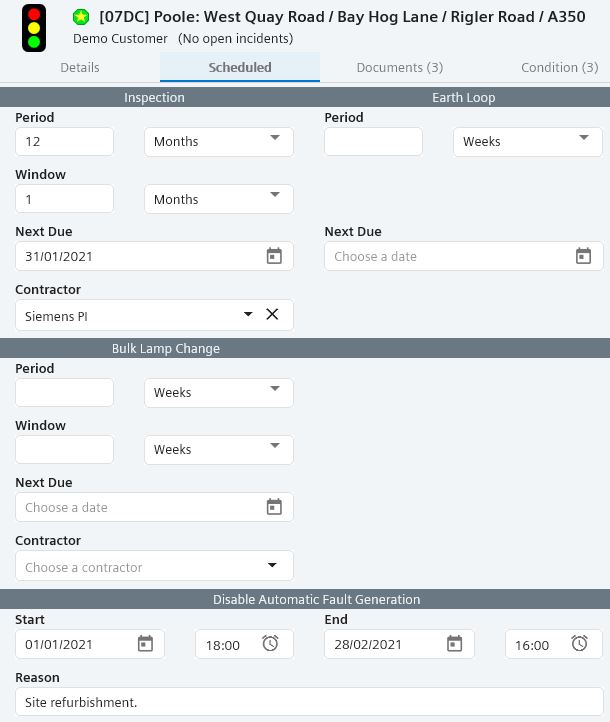|
Periodic Inspections (PIs) are configured for a Site using the Scheduled tab as shown in the example below. |
 |
|
Each site can have 3 types of Periodic Inspection/Job configured. Normally types 1 & 2 have their dates aligned although on different frequencies and use the same contractor. The Contractor set on the site level overrides the contractor set for the fault code. Note that leaving the field blank means that no contractor will be set on the incident. The types are: 1. Inspection (standard PI). Configure the frequency in weeks, the "Window" leading up to the next inspection which will be used to turn the PI into an incident (see below) and the Contractor. 2. Earth Loop (Impedance check). Configure the frequency in weeks. 3. Bulk Lamp Change (Clean). As for standard PIs above At the start of the Window (e.g. 4 weeks before the inspection is due in the example above) the system creates a DRAFT Incident of type: 1. SPD 2. SED 3. SLD
At the ¾ point through the window an overnight process SUMBITS the Incident and it changes to AMBER on the dashboard. If the contractor has been configured to be SAP based it also gets routed through to SAP. At the end of the window, an overnight process changes the Incident to RED on the dashboard and updates the fault code as shown below. This enables the reports to be generated for missed PIs. 1. SPO 2. SEO 3. SLO Once a scheduled task has been completed it may require a report to be uploaded. Where the report is not yet available for upload the user should TEMP CLEAR the fault. The system will insert the current time as the actual restore time and set the fault code to SRD. It will also set the required resolve time for 2 weeks later. At the end of the 2 weeks the system updates the fault code to SRO. Alternatively the Incident can be progressed directly to the CLOSED state and the system will use the current time as the actual resolve time. For availability based contracts where the contractor name includes “Siemens” then availability also starts to get affected based on the categories affected as for any other fault code. |